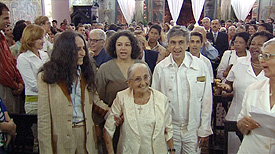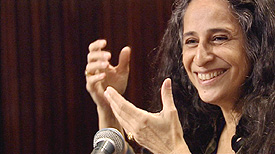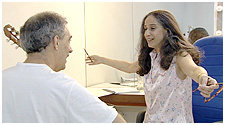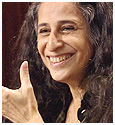|
|
| Film Sequences |
|
| Studio recordings |
|
| In the recording studio of Rio de Janeiro, some of the best Brazilian musicians are brought together for the recording of the CD "Vinicius de Moraes". Under the musical direction of Jaime Alem, Maria Bethânia’s arranger for many years, songs like "Gente Humilde, "Tarde em Itapoa", "Samba da Bençao", "Muhler sempre Muhler" or "Bom Dia Tristeza", progressively take shape. The fifteen musicians mostly play typical Brazilian instruments. |
|
| Each musician is initially recorded alone, in a spontaneous interpretation in which he gives free rein to his musical intuition, before necessary additions and adjustments are made to the composition as a whole. |
 |
 |
|
| Encounters with the artists who are close to her |
|
| Gilberto Gil, Chico Buarque and Caetano Veloso, international superstars and close friends and relatives of Maria Bethânia, tell us about her family, her friends and her music. |
|
| Every day, around noon, Maria Bethânia arrives in the studio to listen to the recordings and sing her parts. Between two work sessions, musicians and members of the Bethânia team agree to reveal their impressions of the singer, her music and her voice as well as describe their collaboration with her. |
|
| Caetano Veloso recalls their childhood and his memories of Vinicius de Moraes who was well-known by Bethânia and himself. He also speaks of their musical collaboration and more generally of his sisters’ role in the world of Brazilian music. |
|
| Gilberto Gil tells us how much the great singer Maria Bethânia, his childhood friend, means to him. |
| Salvador do Bahia |
|
| For us, Maria Bethânia opens the doors of her home in Salvador da Bahia. Like never before, she speaks extensively and freely from the bottom of her heart. She describes her youth, her family, her relationship with Vinicius de Moraes, with her audience and Brazilian music in general ... |
| Santo Amaro da Purificaçao |
|
| In Santo Amaro, Bethânia’s birth town, the whole family gets ready to celebrate the birthday of Dona Cano, her mother of nearly one hundred years old who is a mythical figure in Brazil. Before the family itself continues the celebration, a procession forms in the church bringing together each one of her relatives. We are therefore able to discover more about Brazilian culture and to get a feel for the society in which Maria Bethânia’s musical art developed. |
| The album "Brasileirinho" |
|
| To release her new "Brasileiringo", Maria Bethânia’s choose mythical music hall "Canecão" of Rio de Janeiro to give concerts. The tour will then go on in Salvador de Bahia. In a friendly gesture, Maria invited her friends Miucha and Nana Caymmi to perform with her. In the dressing room, overjoyed and excited after a hugely successful concert, the three friends and accomplices, stars of today’s Brazilian music, recall their childhood and draw up a delightful and unusual portrait of Brazil’s musical landscape. Their conversation is punctuated with a cappella singing, they take a couple of dance steps and the history of this music is embodied before our eyes. We are witness to a true moment of happiness as well as a historical encounter. |
| Maria Bethânia and Nana Caymmi |
|
| Like her father, the composer Dorival Caymmi, Nana Caymmi comes from a large Bahian family of musicians. She suddenly appears in the film like a meteorite in the constellation of the main protagonists of Brazilian music. In the show, she performs a song with Bethânia and recalls the history of Brazilian music and its relationship with Bethânia. |
|
| The singer Miucha, Chico Buarque’s sister was the second wife of Joao Gilberto, the creator of Bossa Nova. She worked closely with Vinicius de Moraes and Tom Jobim and is undoubtedly an important witness of the history of Bossa Nova. |
|



